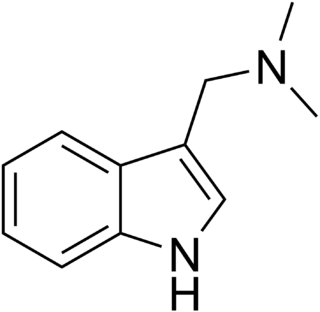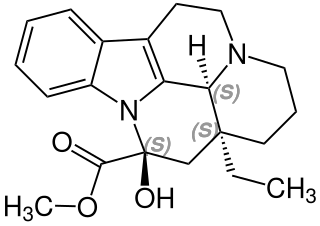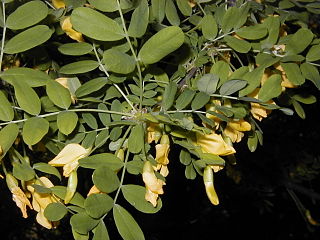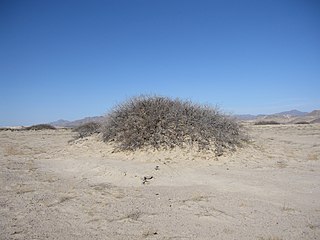
Hippophae is the genus of sea buckthorns, deciduous shrubs in the family Elaeagnaceae. The name sea buckthorn may be hyphenated to avoid confusion with the unrelated true buckthorns. It is also referred to as sandthorn, sallowthorn, or seaberry. It produces orange-yellow berries, which have been used over centuries as food, traditional medicine, and skin treatment in Mongolia, Ladakh, Russia, Ukraine, and northern Europe, which are its origin regions.

Myrica rubra, also called yangmei, yamamomo, Chinese bayberry, red bayberry, yumberry, waxberry, or Chinese strawberry is a subtropical tree grown for its fruit.

Tripterygium wilfordii, or léi gōng téng (Mandarin), sometimes called thunder god vine but more properly translated thunder duke vine, is a vine used in traditional Chinese medicine.

Gramine is a naturally occurring indole alkaloid present in several plant species. Gramine may play a defensive role in these plants, since it is toxic to many organisms.

Malus sieversii is a wild apple native to the mountains of Central Asia in southern Kazakhstan. It has recently been shown to be the primary ancestor of most cultivars of the domesticated apple. It was first described as Pyrus sieversii due to its similarities with pears in 1833 by Carl Friedrich von Ledebour, a German naturalist who saw them growing in the Altai Mountains.

Vincamine is a monoterpenoid indole alkaloid found in the leaves of Vinca minor, comprising about 25–65% of its indole alkaloids by weight. It can also be synthesized from related alkaloids.

Caragana arborescens, the Siberian peashrub, Siberian pea-tree, or caragana, is a species of legume native to Siberia and parts of China and neighboring Mongolia and Kazakhstan. It was taken to the United States by Eurasian immigrants, who used it as a food source while travelling west. In some areas of the United States it is considered an invasive species. Introduced on the Canadian prairies in the 1880's, the hardy caragana provided shelter-belts, wildlife habitat, nitrogen fixation, and windbreaks to prevent soil erosion and snow drifting.

Flueggea suffruticosa is a species of flowering plant in the family Phyllanthaceae. It is a deciduous shrub that is widely distributed in Asia, America, Europe, and Africa. It is one of the 50 fundamental herbs used in traditional Chinese medicine, where it has the name yī yè qiū.

Sophora flavescens, the shrubby sophora, is a species of plant in the genus Sophora of the family Fabaceae. This genus contains about 52 species. It mainly occurs in India, Japan, Korea and Russia.
A xerophyte is a species of plant that has adaptations to survive in an environment with little liquid water. Examples of xerophytes include cacti, pineapple and some gymnosperm plants. The morphology and physiology of xerophytes are adapted to conserve water during dry periods. Some species called resurrection plants can survive long periods of extreme dryness or desiccation of their tissues, during which their metabolic activity may effectively shut down. Plants with such morphological and physiological adaptations are said to be xeromorphic. Xerophytes such as cacti are capable of withstanding extended periods of dry conditions as they have deep-spreading roots and capacity to store water. Their waxy, thorny leaves prevent loss of moisture.

Justicia gendarussa, commonly known as Willow-leaved justicia ,Lapsulis in Creole Seychelles; is a small erect, branched shrub. According to Plants of the World Online it is native to the Indian subcontinent, Indochina, Peninsular Malaysia, Sumatra, the Philippines, and New Guinea, and has been introduced to Nepal, the western Himalayas, Pakistan, southern China including Hainan and Taiwan, eastern Africa, and the Mascarene Islands, Comoro Islands, and Seychelles. It has been described as rare and endemic to India, though those claims are at least confusing, in the context of statements that the plant is widely used in various forms for many of its medicinal and insecticidal properties, and that it is a quick-growing, evergreen forest shrub considered to be a native of China and distributed in Sri Lanka, India and Malaysia.
Kadsura longipedunculata, also known as the Chinese kadsura vine, is a fruit bearing monoecious wild evergreen climbing shrub, that is native to Eastern Asia, Western China and Southern China.This rare and unknown flower is often used for its medicinal properties in Asia.

Gelsemine (C20H22N2O2) is an indole alkaloid isolated from flowering plants of the genus Gelsemium, a plant native to the subtropical and tropical Americas, and southeast Asia, and is a highly toxic compound that acts as a paralytic, exposure to which can result in death. It has generally potent activity as an agonist of the mammalian glycine receptor, the activation of which leads to an inhibitory postsynaptic potential in neurons following chloride ion influx, and systemically, to muscle relaxation of varying intensity and deleterious effect. Despite its danger and toxicity, recent pharmacological research has suggested that the biological activities of this compound may offer opportunities for developing treatments related to xenobiotic or diet-induced oxidative stress, and of anxiety and other conditions, with ongoing research including attempts to identify safer derivatives and analogs to make use of gelsemine's beneficial effects.

A nabkha, nebkha or nebka is a type of sand dune. Other terms used include coppice dune and dune hummock or hummocky dune, but these more accurately refer to similar, but different, sand dune types. Authors have also used the terms phytogenic hillock, bush-mound, shrub-coppice dune, knob dune, dune tumulus, rebdou, nebbe, and takouit.

Akuammicine is a monoterpene indole alkaloid of the Vinca sub-group. It is found in the Apocynaceae family of plants including Picralima nitida, Vinca minor and the Aspidosperma.

Grassland degradation, also called vegetation or steppe degradation, is a biotic disturbance in which grass struggles to grow or can no longer exist on a piece of land due to causes such as overgrazing, burrowing of small mammals, and climate change. Since the 1970s, it has been noticed to affect plains and plateaus of alpine meadows or grasslands, most notably being in the Philippines and in the Tibetan and Inner Mongolian region of China, where 2,460 km2 (950 sq mi) of grassland is degraded each year. Across the globe it is estimated that 23% of the land is degraded. It takes years and sometimes even decades, depending on what is happening to that piece of land, for a grassland to become degraded. The process is slow and gradual, but so is restoring degraded grassland. Initially only patches of grass appear to die and appear brown in nature; but the degradation process, if not addressed, can spread to many acres of land. As a result, the frequency of landslides and dust storms may increase. The degraded land's less fertile ground cannot yield crops, nor can animals graze in these fields. With a dramatic decrease in plant diversity in this ecosystem, more carbon and nitrogen may be released into the atmosphere. These results can have serious effects on humans such as displacing herders from their community; a decrease in vegetables, fruit, and meat that are regularly acquired from these fields; and a catalyzing effect on global warming.
Penicillium paneum is a species of fungus in the genus Penicillium which can spoil cereal grains. Penicillium paneum produces 1-Octen-3-ol and penipanoid A, penipanoid B, penipanoid C, patulin and roquefortine C
The iodate fluorides are chemical compounds which contain both iodate and fluoride anions (IO3− and F−). In these compounds fluorine is not bound to iodine as it is in fluoroiodates.

Securinine is an alkaloid found in Securinega suffruticosa and Phyllanthus niruri.

A psammophyte is a plant that grows in sandy and often unstable soils. Psammophytes are commonly found growing on beaches, deserts, and sand dunes. Because they thrive in these challenging or inhospitable habitats, psammophytes are considered extremophiles, and are further classified as a type of psammophile.















